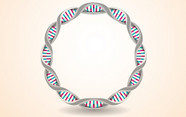Progress in LC over the years has been steady, but much slower than advances seen in techniques like GC. The lag can be attributed to the fact that LC is the core analytical technique of the pharmaceutical industry, in which regulation and validation – rather than development – were the keywords until the end of the 20th century. However, the past decade has seen great advances, thanks to the creativity of scientists from both the academic and industrial world. Today, with LC-MS/MS, we can monitor more than 300 pesticides in our food in less than 20 minutes, and quickly determine the critical quality attributes of large biopharmaceuticals. Developments in LC and MS have led to an increased understanding of the human body in health and disease, which could ultimately improve and extend our lives.
Perfect particles
The greatest impact has come from the development and commercialization of sub-2 µm porous particles and sub-3 µm core-shell particles. With these new columns, analyses are much faster, with at least twice the resolution and improved inertness. This, together with developments in mass spectrometry, has resulted in analytical tools that can characterize complex protein biopharmaceuticals in great detail, identify and quantify more proteins, metabolites and lipids in -omics research, quantify compounds at higher sensitivity in complex samples, identify more impurities in samples, and many other impressive feats. Columns packed with sub-3 µm core-shell particles are especially attractive for routine analysis, as they bypass the need for high-pressure instrumentation. These particles now come in many flavors with various chemistries, excellent lifetimes, higher pore sizes and improved pH stability.
LC squared
Remarkable developments have also been made in 2D-LC (both heart-cutting and comprehensive). AJP Martin described the benefits of two-dimensional chromatography as early as 1944, writing “… but the two-dimensional chromatogram is especially convenient, in that it shows at a glance information that can be gained otherwise only as the result of numerous experiments” (1). What has, until recently, been developed mainly in universities is now commercially available in an improved and robust form, and is emerging as a very powerful technology in disciplines ranging from (bio)pharmaceutical analysis to petrochemistry. I expect to see 2D-LC gain momentum in the next five years and be widely applied as a generic method for multiple samples from different fields.
Despite the enormous potential of 2D-LC and the gain in resolution typically achieved, it too can remain a compromised technique. Depending on how 2D-LC is performed, the technique suffers from issues with flow and mobile-phase incompatibilities, sensitivity, reproducibility, immature data analysis software, and others. Various groups are hard at work to make sure that these shortcomings will be challenged in the coming years.
Better columns
We still need better chromatographic resolution for the analysis of bio- and synthetic macromolecules, and for the complex samples encountered in life sciences, there is never enough resolving power. One development I hope to see in the next five years is the advent of robust 1 mm bore columns with reduced plate heights – as low as for 4.6 mm ID columns – and instrumentation that can cope with these column characteristics, with no extra-column band broadening. I find it strange that this area has been neglected, while attention is lavished on chip-based and capillary columns with limited performance.
However, I would make an exception for the long micropillar array columns (µPAC) developed at the Free University of Brussels by Gert Desmet’s group and now commercialized by PharmaFluidics. By using a lithographic etching process to create a perfectly ordered separation bed, the mobile-phase flow pattern through µPAC columns adds very little dispersion to the overall separation, giving rise to sharper peaks, better resolution and increased sensitivity. The freestanding nature of the pillars also leads to much lower back-pressure, allowing the use of very long column formats. Improvements to pillar density and surface chemistry are still needed to make µPAC generally applicable, but the principle is attractive and the results impressive. Exploiting the full potential of µPAC is hampered by the instrumentation available (nano- and capillary LC), so there is a clear need to rethink and redesign the current instrumentation.
The next 10 years…
Looking further ahead, I foresee a number of changes:
- I expect new developments in electro-driven separations. With renewed interest and research efforts it should be possible to profit more from electro-osmotic flow.
- Mass spectrometers will become the standard LC detectors and in (bio)pharmaceutical routine analysis (GMP, QA/QC), mass spectrometers will be introduced and one single LC-MS method will replace various HPLC release methods.
- 2D-LC will gain momentum, and more and more companies will enter this market.
- Sub-3 µm core-shell columns and instrumentation up to 600 bars will become the standard in routine labs.
- µPAC columns will be intensively evaluated for R&D in combination with state-of-the-art MS, and second-generation µPAC columns will become available.
- For the happy few able to take advantage, sub-1 µm particles will be introduced, requiring adapted instrumentation.
- Knowledge and know-how will further decline. As we’ve already seen in GC, LC systems will increasingly become black boxes.
The electric light did not come from the continuous improvement of candles; hence, someone might come up with a completely new separation principle, outperforming LC as we currently know it.
- R Consden et al., Biochem J, 38, 224–232 (1944).
Koen Sandra is CEO, RIC, Kortrijk, Belgium.















